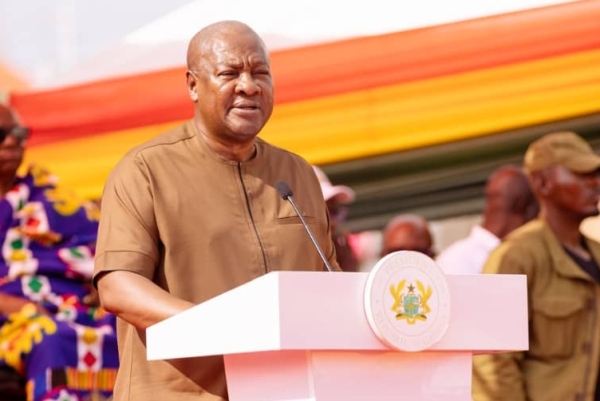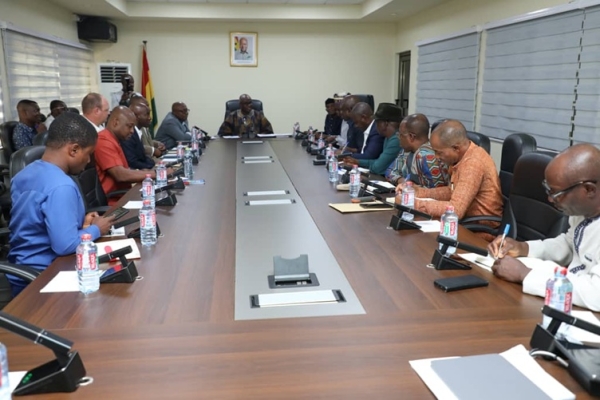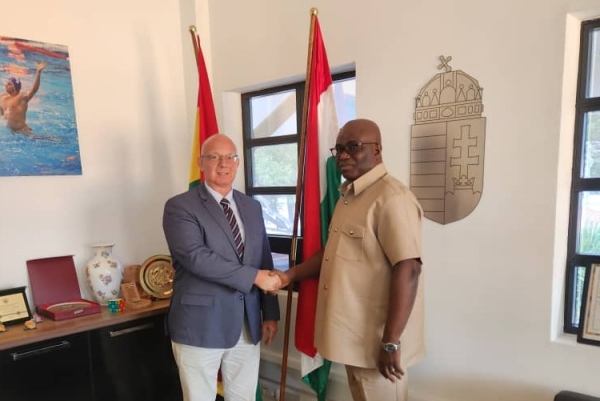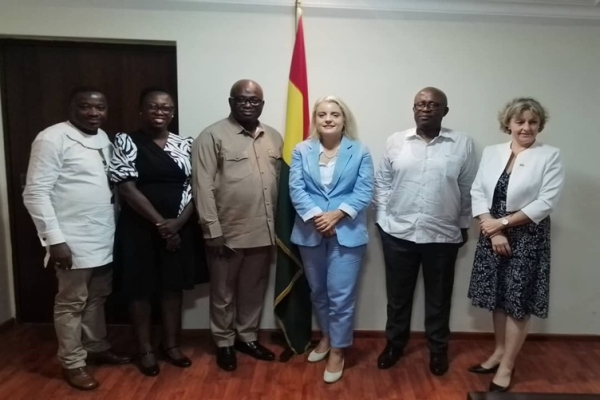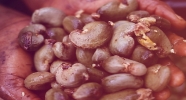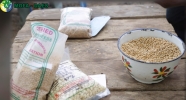INTRODUCTION
Atwima Nwabiagya District was carved out of the former Atwima District in 2004 by the legislative Instrument 1738. The District exists to see to improve the quality of life of every inhabitant that stays in its area of jurisdiction. This development is achievable through the formulation and implementation of realistic policies; while using locally available and outside human and material resources to jointly work with local people to ensure sustainable development.
PHYSICAL CHARACTERRISTICS
Location And Size Of The District
The Atwima Nwabiagya District lies approximately on latitude 6075’N and between longitude1045 and 2000’ west. It is one of the 21 political and administrative Districts in Ashanti Region. It is situated in the western part of the region and shares common boundaries with Ahafo Ano South and Atwima Mponua Districts (to the west), Offinso District (to the North), Amansie-West and Bosomtwe-Atwima Kwanwoma Districts (to the South), Kumasi Metropolis and Kwabre Districts (to the East). It covers an estimated area of 294.84 sq km. the District capital is Nkawie.
Topography and Drainage
The District has an undulating topography. The lands have average heights of about 77 meters above sea level. The high lands have gentle to steep slopes.
The surface area of the district is mainly drained by the Offin, Owabi and Tano rivers. There are however, several steams in the district. These include Kobi and Dwehen. Two major Dams, Owabi and Barekese have been constructed across the Owabi and the Offin rivers respectively. These dams supply pipe borne water to the residents of Kumasi and its environs.
Climate and Vegetation
Climate:
The District lies within the wet semi-equatorial zone marked by double maximum rainfall ranging between 170cm and 185cm per annum. The major rainfall season is from March to July and minor season is between August and mid-November.
Temperature is fairly uniform ranging between 270C (August) and 310C (March). A relative humidity of about 93 percent is characteristic of the district.
Vegetation
The vegetation found in the district is predominantly the semi-deciduous type. The vegetation type has largely been distributed by man’s activities, thus, depriving it of its valuable tree species and other forest products.
There are however, large acres of forest reserves. These include the Gyemena, Tano Offin, and Owabi Water Works Forest Reserves.
Soils
The predominant soils in the district are the Kumasi-Asuansi Compound Association, the Kobeda-Eshien Compound Association and the Nyanano-Opimu Simple Association. The Kumasi-Asuansi Compound Association are excessively drained whilst the Kobeda-Eshien Compound Association are poorly drained and waterlogged during the rainy season. The soils in the district are good for cultivation of a variety of crops such as Maize, rice, sugar cane, coffee, cocoa, cassava, vegetables, cocoyam, yam, citrus, ginger, oil palm and plantain.
Demographic Characteristics
Population Size, Growth rate and Sex Ratio
The total population of the District, according to the 2000 population and housing census was 126,183, with an annual growth rate of 3%. The Census revealed that the presence of more males than females. The projected population of the district for 2006 (using the geometric method) is 150,675.
Population Density
The district has a population density of 428 persons per sq. km. The district in terms of land area, is third in the region, after Kumasi Metropolis and Kwabre District, which have 5,319 and 659 per sq. km respectively.
Rural-Urban Population
The district is predominantly urban. 34.5% of the population lives in the rural settlements while 65.5% live in the urban/peri-urban areas of the district. Major settlements in the district include Abuakwa, Nkawie (the district capital), Toase, Asuofua, Barekese, Atwima Koforidua, Asenemaso etc.
Population Distribution by Area Councils
The Population Distribution by Area Councils is indicated in the table below.
| Town/Area council | Population | % | Projected population for 2006 | ||
| Male | Female | Total | |||
| Abuakwa | 17,171 | 17,272 | 34,449 | 27.3 | 41,136 |
| Akropong | 14,056 | 13,987 | 28,043 | 22.23 | 33,486 |
| Nkawie-Toase | 9,376 | 8,766 | 18,142 | 14.38 | 21,663 |
| Barekese | 9,512 | 9,523 | 19,035 | 15.09 | 22,730 |
| Adankwame | 8,676 | 8,919 | 17,595 | 13.95 | 21,010 |
| Afari | 4,508 | 4,411 | 8,919 | 7.05 | 10,650 |
| Total | 63,299 | 62,884 | 126,183 | 100.00 | 150,675 |
Source: Compiled from 2000 census.
ECONOMIC ACTIVITIES
The main economic activity in the district is agriculture. About 67% of the working population is engaged in it. The other major economic activities are manufacturing (3.5%), services (17.5%) and commerce (12%).
INDUSTRY
The main types of industries found in the district are small and medium scale manufacturing enterprises.
These include: food processing, wood and wood products, textiles/dressmaking, brick and tile making, distillery, chemical products, pottery, clayware and ceramics, fabricated metal products, leather works, beads making, block moulding and mineral water production. Some of the notable industries in the district include, Darko and Mfum Farms Feed Mills, Afari and Mfensi Pottery, Fabi Timbers and others.
Plans are far advanced to establish Poultry Processing and Ginger Processing Factories at Akropong and Gyankobaa respectively under the President’s Special Intitiative and the Rural Enterprise Development Project.
The district has formed and registered a company with the name Atwima Quality Ginger Products Ltd. The aim is to produce and process ginger for the local and external markets.
About 12% of the working population in the district is engaged in trading/commercial activity (buying and selling).
Types of trading /commercial activities found in the district includes trading in foodstuffs, provisions, spare parts, alcoholic and soft drinks, cooked foods, wood and wood products, plastic products, chemicals, fuel products and lubricants, etc
Apart from a few who trade in defined market places, most trading activities in the district are located along roads and residential neighborhoods. Most of the traders are small size retailers who deal in assorted wares.
AGRICULTURAL ACTIVITIES
FARMER POPULATION
The district has a farmer population of about 29,700 of which 52% are females and 48% being males. Women activities in the agricultural sector in the district cut across from crop sector, livestock, processing, and marketing.
The District Agricultural Development Unit (DADU) Head Office is located at Nkawie-Toase the District capital. The directorate has staff strength of 30, i.e. 9 females and 21 males.
The Atwima Nwabiagya District Agricultural Development Unit is made up of four zones namely Abuakwa, Amanchia, Barekese and Mfensi. The zones are supervised by District Development Officers (DOs). Each zone is made up of eight operational areas (op) which are manned by Agricultural Extension Agent (AEAs) and each operational area is made up of eight communities.
Agricultural activities in the DADU can be categorized into crops and livestock sub-sectors. On the scale of operation, the activities can be grouped into large, medium and small scale.
The crop sub-sector can be grouped into tree crops and food crops. The livestock sub sector into, large ruminants, small ruminants, non ruminant and poultry.
The other areas which are less known are the non-traditional sector.
CROPS
The crops sub-sector includes tree and food crops. These are cultivated throughout the whole district with some areas having advantage over others.
TREE CROPS
The main tree crops cultivated in the District include: cocoa, citrus and oil palm
COCOA
Cocoa is produced in most part of the Districts. However the major producing areas are: Adegya, Wurapong, Barekese, Boahenkora I and II, Fufuo, Amanchia, Kobeng, Seidi, NkawiePanin, Nkakom, Nerebehi, Nkontonmire, Asakraka and Sawua.
CITRUS
Citrus cultivation cuts through the entire District with major producing areas as Adankwame, Toase, Daabaa, and Asamang. These areas have high concentration of large commercial farms. Farms sizes ranges between five (5) hectares (ha) to twenty five (25) hectares. Other areas have farms sizes ranging between 2.5 ha to 4 ha.
It is estimated that the District produces about 225,000 mt of citrus per anum.
Some of the large scale farms are: Nana Attakora, Nana Kwadwo Addai, Jokas Farms, B.B Yirenkyi and Nana Kweku Nsia Farms.
OIL PALM
Oil palm is not widely produced in the District. However some few medium to large scale farms are scattered throughout the District with some new farms being established in recent times; Wioso, Barekese, Atwima Koforidua, Nkawie Panin, Fankomawe, Zebukrom and Nerebehi are areas which produce the crop.
FOOD CROPS
Food crop production is the mainstay of the district agricultural setup. The level of production ranges from backyard, small, medium to large scale and commercial farms.
Maize, cassava, plantain, cocoyam and rice are the major food crops produced in the District. These crops are widely cultivated throughout the District.
MAIZE
Maize is cultivated throughout the whole district with major producing areas as Amanchia, Seidi, Kobeng, Wioso, Toase, Barekese, Fufuo, Adankwame, Mfensi, Mabang, Daabaa and Amadum Adankwame with average farm size ranges between 2.5 – 15 ha. Total cropped area is estimated to be 7,076 ha with the District production estimated to be about 14,140 mt.
RICE
Rice production is one area where the District has made a great stride and has seen an increase in total area under cultivation from a little over 45ha to over 1,250ha. This is expected to increase further. The increase is due to the development of many valleys under the block farm programme in the district.
Major areas of production are Amadum-Adankwame, Mfensi, Sokwa, Ntensere, Afari, Tabre, Sepaase, Nerebehi.
GINGER
Ginger production is one crop which the district is noted for. The District has a comparative advantage due to the soil type. Major production areas are Gyankobaa, Toase, Wioso, Amanchia, Seidi, Kobeng. Farmers in other parts of the district have now adopted the crop. Production is estimated to be around 260,000Mt per annum.
VEGETABLES
The closeness of the District to the Kumasi metropolis, a major market, has led to most farmers engaging in the production of both exotic and local vegetables. Also the District is drained by some Rivers; Owabi and Offin which provide water for irrigating the vegetables.
LOCAL VEGETABLES
Local vegetables cultivated include Tomatoes, pepper, okra, garden eggs, onions, alefi, ayoyo and nkontomire.
EXOTIC VEGETABLES
Cabbage, carrot, cucumber, green pepper and water melon are the exotic vegetables cultivated.
Areas of production includes: Barekuma, Maabang, Barekese, Adankwame, Afari, Sepaase, Mim, Nerebehi, Asamang, Toase, Wioso, Amadum Adankwame, Tabree, Nkakom and Kyereyaase
CERTIFIED SEED PODUCTION
The District has the highest concentration of certified seed producers in the region cultivating over 350ha of various crops such as maize (obaatanpa, mamaba, golden jubilee and Atubi), cowpeas (asetenapa and asuntem). Rice seed production is also catching up well in the District. Areas of operation includes: Toase, Wioso, Gyankobaa and Fufuo. The District can boast of three large scale certified seed production units which are in production of hybrid seeds eg; Mamaba and Atubi.
CASSAVA, PLANTAIN AND COCOYAM
Major production areas includes : Amanchia , Seidi, Wioso, Wuranpong, Barekese, Fufuo, Adankwame, Mfensi, Nkonteng, Daabaa, Kapro, Abira, Adegya, Akuapim, Boahenkwa, i and ii. Production levels of these crops are quite high.
LIVESTOK SECTOR
The livestock sector comprises of ruminants, poultry, piggery and grass cuter.
CATTLE
The district has 8 cattle ranches situated at Toase, Afari, Nkawie, Maabang, Fufuo, Koforidua, Ahwia and Daabaa. Stock levels range between 30-300 herds. Total production is estimated at 1000 herds
SHEEP AND GOAT
Sheep and goat production is not practiced on large scale in the District. However there are few large, medium to large scale production units scattered around the District with stock level ranging between 15 to 100 herds. Production figures for small ruminants are estimated 5,300.
PIG PRODUCTION
The district can bost of some medium to large scale piggery with stock level ranging between 200-1,500pigs. Areas include Maabang, Adankwame, Sokwai, Akropong, Amadum, Adankwame, Darbaa, Toase and Gyankobaa.
POULTRY
Poultry industry is the area that the district has greatest comparative advantage. Poultry production ranges from small, medium, and large to commercial enterprises. Farms are spread along the length and breadth of the district, with Adankwame, Maabang, Asuofia, Akrpong, Darbaa, Afari, Sepaase, Wioso, Gyankobaa, Amadu Adankwaame, Tabre, Atwima Koforidua having the largest concentration. Bird population ranges from 250 – 50,000 even up to 60,000 per farm. Some of the commercial farms include Mfum Farms, Boggie Farms, Topman Farms, Marbang Farms and Brotherman Farms.
Turkey, Guinea Fowl and Ducks are also produced in the district on small scale. Turkey production is gaining some level of attention.
FARMER BASED ORGANISATION (FBOs)
The District has a total of 85 Farmer Based Organizations comprising 2,300 males and 1,800 females. These groups are involved in production and processing.
MARKET AND MARKETING
This District has 5 daily and 2 weekly markets. The major market centre is the district capital Nkawie which is on every Wednesday. The location of the district puts it at a very advantageous position when it comes to marketing.
The district shares boundary with the Kumasi Metropolis and serve as the market center for most farm produce. The good road network linking all the zones makes transporting food stuff to the central market in Kumasi less difficult.
Also the Abuakwa-Bibiani road provides a very good means for traders to transport maize and other food stuffs to Bibiani and beyond.
NGO ACTIVITIES
Three NGOs are currently operating in the district namely Self Help International, Sustainable Tree Crop Programme (STCP) and Agricultural Development and Value Chain Enhancement Project (ADVANCE).
All the three NGOs are into capacity building. However Self Help International provides credit in cash and kind such as inputs for the production of QPM maize, which they purchase for the school feeding programme
AGRICULTURAL SERVICES
The proximity of the District to the Kumasi metropolis gives rise to a number of agricultural service centres such as, agro chemical and veterinary shops, making agro-inputs and veterinary drugs readily available to farmers.
PROCESSING/AGRO- INDUSTRIES
The district has a number of agro processing centers which are into processing of gari, oil palm, palm kennel and soya milk. The district has two agro based industries located at Atwima Koforidua and Abuakwa which are into soya oil production and soya cake. Most of the poultry farms have their own feed mills.
AQUACULTURE
The district has fingerlings production centre at Nkawie, where fingerlings are raised and sold to farmers.
DADU
FIELD DEMONSTRATIONS
A total of 16 demonstrations were established by AEAs throughout the District which involve crops such as improved maize and vegetables using poultry manure. Four (4) livestock demonstrations were also established in poultry production using Quality Protein Maize (QPM)..
FERTILIZER SUBSIDY
Three dealers were involved in the fertilizer subsidy programme. A total of fertilizers 12,700 bags were sold comprising; NPK 6,800, Urea 2,500, SOA 3,400.
SPECIAL PROJECTS
Special project undertaken in the District are Root and Tuber Improvement and Marketing Programme (RTIMP) and Japan International Research Center for Agricultural Science (JIRCAS).
RTIMP
Cassava and yam are the two major crops been promoted by the Root and Tuber Improvement Programme in the District. A total of 4 ha secondary multiplication field has been established in the District.
CASSAVA
The department is promoting improved cassava production for farmers which will later be given to processors.
It supplies planting materials to interested farmers for production. The District has supplied over 3,600 bundles of cassava planting material for the cultivation of 36.2 ha to tertiary fields.
YAM
The District is establishing secondary multiplication sites for yam. A total of 0.6 ha has so far been established with an approximate 24,000 mini setts located in these communities Toase, Kobeng and Amakye Bare
The purpose of the activity is to produce approximately a million setts for tertiary farmers in 2011.
LAND INFRASTRUCTURAL DEVELOPMENT IN RICE PRODUCTION
Japan International Research Centre for Agricultural Science is in an infrastructural development to assist farmers in modern land development for rice cultivation. The beneficiary communities under this project have well developed irrigation and water management fields.
The communities involved are; Sokwai, Ntensere, Afari, Koforidua-Akropong, Amadum-Adankwame, Amakye Bare and Aninkoromah.
A total of twelve farmers comprising 11 males and 1 female are involved in the cultivation of 26 ha land under the project.
SPECIAL PROGRAMMES
There are a few programmes that are currently been run in the District in the crop and animal production sectors. These include the, livestock in kind, National Cockerel Project and the block farm programmes.
LIVESTOCK IN KIND
Since its inception in 2010, five (5) small ruminant farmers (3 males and 2 female) have so far benefited from the programme which provides ten (10) sheep (1 ram and 9 ewes) to farmers for rearing. After a period of two years these animals (10 offspring’s) are turned over to other small ruminant farmers.
COCKEREL
A total of 520 cockerels have so far been sold out to about 29 small holder poultry farmers to improve their livelihood and the supply of meat under the National Cockerel programme District wide.
BLOCK FARM
A total of 225 acres of rice involving 71 males and 26 females in 2010 and 82 acres involving 31 males 23 females in 2011 have been cultivated. Estimated production for 2010 was 720 mt paddy.
A total of 95 acres of certified seed were also produced under the block farm involving 5 farmers.
Estimated production of certified seed for 2010 was 107 mt.
NEW INITAITIVES
Farmer Field Fora (FFF), an innovation for mutual learning for smallholder farmers, extension agents and researchers on cassava production is been embarked on RTIMP fields in the District.
Two (2) communities have been selected for the programme: fifty (50) farmers each from community will benefit from this programme: Nkawkom and Seidi
ACHIEVEMENTS 2008 – 2010
- Systematic increase (10% per annum) in the production of the following crops; maize, rice, cassava, plantain and ginger.
- Increase in stock numbers of livestock through the introduction of improved breeds and selection techniques.
- Successful control of livestock and crop diseases.
- Promotion of the use of locally available food stuffs to promote the consumption of balance diets by farmers.
- Successful implementation of the fertilizer subsidy programme which benefited farmers immensely and led to increased productivity.
- Successful compilation and onward submission of all administrative performance and financial reports to the regions on time.
- The upgrading of three female staff: one BSc and two Diploma



